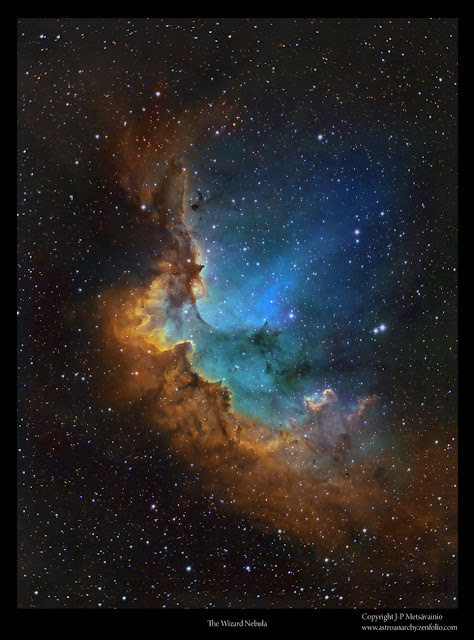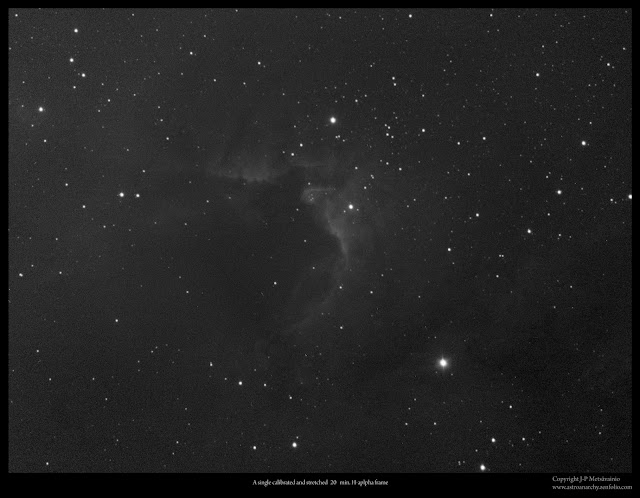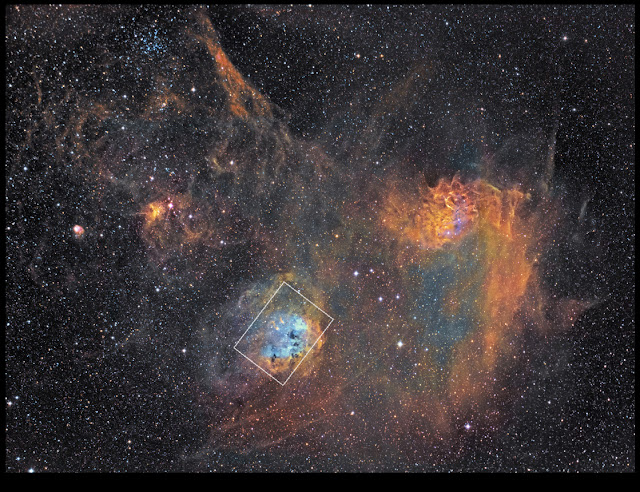COPYRIGHT, PLEASE NOTE
All the material on this website is copyrighted to J-P Metsavainio, if not otherwise stated. Any content on this website may not be reproduced without the author’s permission.
BUY A MUSEUM QUALITY POSTER
BUY A POSTER:https://astroanarchy.zenfolio.com/
Thursday, December 13, 2012
The Pelican Nebula reprocessed
I reprocessed this image since weather doesn't support imaging up here and my processing work flow is somehow different now. My new work flow produces much softer images, I think.
The "Pelican Nebula"
Ra 20h 50m 48s Dec +44° 20′ 60"
R=Sulfur, G=Hydrogen and B=Oxygen.
A closeup
Info
The Pelican Nebula (also known as IC5070 and IC5067) is an Hydrogen emission region associated with the North America Nebula in the constellation Cygnus. The nebula resembles a pelican in shape, hence the name. The Pelican Nebula is , close to Deneb, and divided from its brighter, larger neighbor, the North America Nebula, by a molecular cloud filled with dark dust. Distance is about 1800 light years
Natural color composition from the emission of ionized elements, R=80%Hydrogen+20%Sulfur, G=100%Oxygen and B=85%Oxygen+15%Hydrogen to compensate otherwise missing H-beta emission. This composition is very close to a visual spectrum.
Orientation
The area of interest is marked with a white rectangle. This image shows a large portion of constellation Cygnus, North America Nebula, NGC 7000 at right and Pelican Nebula at left. This image is a small part of very large mosaic image of the Cygnus.
Image showing a light emitted by the ionized Hydrogen, H-alpha
Technical details
Processing work flow:
Image acquisition, MaxiDL v5.07.
Stacked and calibrated in CCDStack.
Deconvolution with a CCDSharp, 30 iterations.
Levels, curves and color combine in PS CS3.
Camera QHY9,
Optics Meade LX200 GPS 12" forced to @ f4.65
Guiding with SXV-AO active optics unit 11Hz
Filters
Baader H-alpha 7nm, 6h, 20 min subs
Baader O-III 8,5nm 1h, 10 min. subs binned 3x3
S-II 1,40h, 10 min subs binned 3x3
Original processing can be seen here:
Ps.
A study about an apparent size in the sky
More info in here:
The size of the Moon (0.5 degrees) is marked at first image in the series.
Wednesday, December 12, 2012
The Wizard Nebula reprocessed
I reprocessed this image since weather doesn't support imaging up here and my processing work flow is somehow different now. My new work flow produces much softer images, I think.
NGC 7380, Sh2-1142, the "Wizard Nebula", in Cepheus
Ra 22h 47m 0s Dec +58° 06′ 00″
R=Sulfur, G=Hydrogen and B=Oxygen.
A closeup
Info
NGC 7380 is a catalog number of the open star cluster inside Wizard nebula, SH2-142.
Nebula locates in constellation Cepheus, about 7000 light years from my home.
Natural color composition from the emission of ionized elements, R=80%Hydrogen+20%Sulfur, G=100%Oxygen and B=85%Oxygen+15%Hydrogen to compensate otherwise missing H-beta emission. This composition is very close to a visual spectrum.
An experimental starless version
This image shows just the gas formation, without stars interfering.
Previous version
same raw data is used here
Technical details:
Processing work flow:
Image acquisition, MaxiDL v5.07.
Stacked and calibrated in CCDStack.
Deconvolution with a CCDSharp, 30 iterations.
Levels, curves and color combine in PS CS3.
Telescope, Meade LX200 GPS 12" @ f5
Camera, QHY9 Guiding, SXV-AO @ 6,5Hz
Image Scale, 0,75 arcseconds/pixel
Exposures H-alpha 15x1200s, binned 1x1
S-II 1x1200s, binned 4x4
O-III 1x1200s, binned 4x4
Beside data here, a color information from an older wide field image is used.
Image can be seen here: http://astroanarchy.blogspot.fi/2011/02/sh2-142-wizard-nebula-wide-field.html
A study about an apparent scale in a sky
Monday, December 10, 2012
Elephant's Trunk nebula reprocessed
Weather doesn't support any imaging, so I reprocessed an older image, the Elephant's Trunk nebula.
Elephant's Trunk
A detail in IC 1396 emission nebula
Image in mapped colors from the light emitted by ionized elements.
Red=Sulfur, Green=Hydrogen and Blue=Oxygen.
Buy a photographic print from HERE
Buy a photographic print from HERE
The elephant's Trunk nebula is a concentration of interstellar gas and dust in the star cluster IC 1396.
This ionized gas region locates in the constellation Cepheus about 2400 light years away.
Formation is coursed by a stellar wind, radiation pressure, from a group of massive young stars.
Natural color composition from the emission of ionized elements, R=80%Hydrogen+20%Sulfur, G=100%Oxygen and B=85%Oxygen+15%Hydrogen to compensate otherwise missing H-beta emission. This composition is very close to a visual spectrum.
Buy a photographic print from HERE
A detail
At the time of imaging, the seeing was very good, HWFM ~2.5
A wide field image of the area
The Trunk formation at bottom middle
More info about this image HERE.
Buy a photographic print from HERE
A Gargoyle of the sky
A Gargoyle?.. See HERE
Technical details
All technical details are with an original image HERE
Sunday, December 9, 2012
The Cave Nebula
I shot this target 29.11. but I'm publishing it now since this one was very hard to process due to its dimness.
Cave Nebula, Sharpless 155 (Sh2-155)
In constellation Cepheus
Red=Sulfur, Green=Hydrogen and Blue=Oxygen.
The Cave Nebula, Sh2-155 or Caldwell 9, is a dim and very diffuse bright nebula within a larger nebula complex containing emission, reflection, and dark nebulosity. It is located in the constellation Cepheus. The reflection, wide band, component can't be seen in my image, since this is a narrowband one.
Distance is about 2400 light years.
Distance is about 2400 light years.
Natural color composition from the emission of ionized elements, R=80%Hydrogen+20%Sulfur, G=100%Oxygen and B=85%Oxygen+15%Hydrogen to compensate otherwise missing H-beta emission. This composition is very close to a visual spectrum.
Orientation in a wide filed image
Area of interest is marked as a white rectangle. More info about this image HERE.
An apparent size of the full Moon is marked at the lower right corner for a scale.
Click for a large image.
Technical details:
Processing work flow:
Image acquisition, MaxiDL v5.07.
Stacked and calibrated in CCDStack2.
Levels, curves and color combine in PS CS3.
Optics, Meade LX200 GPS 12" @ f5
Camera, QHY9
Guiding, SXV-AO, an active optics unit, and Lodestar guide camera 8Hz
Image Scale, ~0,8 arc-seconds/pixel
15x 1200s exposures for the H-alpha, emission of ionized Hydrogen = 5h
Narrowband cahnnels for ionized Oxygen and Sulfur are taken from an older wide field image seen above.
Ps.
A single 20 min. H-alpha frame
Calibrated with Bias corrected flat and Dark masters in CCDStack
1200 seconds of H-aplha light with 12" SCT @ f5 and QHY9 astrocamera.
Image is scaled down 50% from original.
Friday, December 7, 2012
A quick one, Sh2-106
This is a kind of snapshot, only one hour of H-alpha filtered light. Sh2-106 is a compact star forming emission nebula in constellation Cygnus. I was planning to shot several hours of lights fro this onae in all three bands for a RGB-colors. How ever, this is a very small nebula and it needs a good seeing to work with. Seeing has been so poor up here, that I haven't been able to finalize this work. Maybe it'll work at next Autumn season....
Sharpless 106
In Cygnus, RA: 20h 30m 51.0s Dec: +37° 24' 35 Mag: 14.5, Distance: ~2000 ly
A colorized H-alpha emission image.
Sharpless 106 (Sh2-106) is a star forming region surrounded by dust and gasses in Cygnus. The central star is approximately 15 times the mass of our Sun and about 100,000 years old. Hourglass shape is coursed by a strong solar winds and material ejected from the star. The star is close to the bottom opening of the nebula in this image which glows the brightest. There are many sub-stellar objects forming within the nebula and may result in a cluster of 50 to 150 stars someday in future.
Technical details:
Processing work flow:
Image acquisition, MaxiDL v5.07.
Stacked and calibrated in CCDStack2.
Levels and curves in PS CS3.
Optics, Meade LX200 GPS 12" @ f5
Camera, QHY9
Guiding, SXV-AO, an active optics unit, and Lodestar guide camera 8Hz
Image Scale, ~0,8 arc-seconds/pixel
3 x 1200s exposures for the H-alpha, emission of ionized Hydrogen = 1h
From the bottom of my Soul
New imaging project, IC 1848, the Soul Nebula. This season I have worked with a longer focal length instrument, my old Meade LX200 12". This image shows a detail from a much large Nebula complex.
Soul Nebula detail
In constellation Cassiopeia
Image in Mapped colors, Red=S-II, Green=H-alpha and Blue=O-III
Click for a large image.
Soul Nebula (Sharpless 2-199, LBN 667) is emission nebulae in Cassiopeia at a distance of 7500 light years. The object is more commonly called by the cluster designation IC1848.
This complex is the eastern neighbor of IC1805 (Heart Nebula) and the two are often mentioned together as the "Heart and Soul".
Image in visual colors, combined from light emitted by the ionized elements, H-a, S-III and O-III
Click for a large image.
A mosaic
I have shot an other detail from this nebula complex back in 2009. This new and older detail are overlapping, so I was able to do a two frame mosaic out of them.
A two frame mosaic of the Soul Nebula in mapped colors.
Click for a large image.
Mosaic in visual colors.
Click for a large image.
Soul Nebula in wide field format
Area of interest is marked as a white rectangle. More info about this image HERE.
Click for a large image.
Image is showing both, the Heart and the Soul Nebulae. More info about this image in HERE.
Click for a large image.
Technical details:
Processing work flow:
Image acquisition, MaxiDL v5.07.
Stacked and calibrated in CCDStack2.
Levels, curves and color combine in PS CS3.
Optics, Meade LX200 GPS 12" @ f5
Camera, QHY9
Guiding, SXV-AO, an active optics unit, and Lodestar guide camera 8Hz
Image Scale, ~0,8 arc-seconds/pixel
24x 1200s exposures for the H-alpha, emission of ionized Hydrogen = 8h
Narrowband cahnnels for ionized Oxygen and Sulfur are taken from an older wide field image seen above.
Melotte 15, a closeup
I published the imaging project of Melotte 15 few days ago. This time I made a closeup images out of the same material.
The heart of the Heart, Mel 15
Image is in visual colors, combined from light emitted by the ionized elements, H-a, S-III and O-III
Click for a large image.
The interesting structure in the center of the image is a giant area of hydrogen gas that is caused to glow by the intense ultraviolet radiation from the massive stars of the Melotte 15 star cluster.
Dust and gas clouds are twisted by the pressure of the intense radiation, the solar wind.
This formation is estimated to be 7,500 light years away from Earth, North is up.
Image in Mapped colors, Red=S-II, Green=H-alpha and Blue=O-III
Click for a large image.
Orientation in IC 1805, the Heart Nebula
The area of interest is marked as a white rectangle.
A 100% closeup
Not a bad resolution for an old Meade LX200 12" telescope. Seeing wasn't very good at the time, FWHM varied between 3,5 to 4,5. A light, 50% weighted deconvolution was added to stacked image, it lowered the FWHM value down to ~2.9
Not a bad resolution for an old Meade LX200 12" telescope. Seeing wasn't very good at the time, FWHM varied between 3,5 to 4,5. A light, 50% weighted deconvolution was added to stacked image, it lowered the FWHM value down to ~2.9
Technical details:
Processing work flow:
Image acquisition, MaxiDL v5.07.
Stacked and calibrated in CCDStack2.
Levels, curves and color combine in PS CS3.
Optics, Meade LX200 GPS 12" @ f5
Camera, QHY9
Guiding, SXV-AO, an active optics unit, and Lodestar guide camera 8Hz
Image Scale, ~0,8 arc-seconds/pixel
45 x 1200s exposures for the H-alpha, emission of ionized Hydrogen = 15h
Narrowband cahnnels for ionized Oxygen and Sulfur are taken from an older wide field image seen above.
Wednesday, December 5, 2012
Sharpless 112 (Sh2-112)
Yesterday, before the clouds rolled in, I got four hours of light emitted by the ionized hydrogen (H-alpha) for this target. I started this project back in 2010 but for some reason never finalized it. Total exposure time is now nine hours.
Sharpless 112
An emission nebula in constellation Cygnus
Sharpless 112 is an emission nebula in Cygnus at distance ~5500 light years.
Not a very bright one, there are lots of dim background nebulosity but my 7h of exposures for H-a is not enough to show it well.
Image in mapped colors from the light emitted by ionized elements.
Red=Sulfur, Green=Hydrogen and Blue=Oxygen.
Technical details:
Processing work flow:
Image acquisition, MaxiDL v5.07.
Stacked and calibrated in CCDStack2.
Levels, curves and color combine in PS CS3.
Optics, Meade LX200 GPS 12" @ f5
Camera, QHY9
Guiding, SXV-AO, an active optics unit, and Lodestar guide camera 8Hz
Image Scale, ~0,8 arc-seconds/pixel
21 x 1200s exposures for the H-alpha, emission of ionized Hydrogen = 7h
3 x 1200s exposures for the O-III, emission of ionized Oxygen = 1h
3 x 1200s exposures for the S-II, emission of ionized Sulfur = 1h
Monday, December 3, 2012
Melotte 15 in IC 1805, project finalized
After struggling several nights with malfunctioning devices, in freezing -20 centigrade wind, I managed to collect enough data to finalize my Melotte 15 project. (I did lost skin from my finger tips, while fixing various problems out there...)
The heart of the Heart
Melotte 15 (Mel 15) Total exposures 45x1200s = 15h
Be sure to click for a full size image!
Buy a photographic print from HERE
Buy a photographic print from HERE
The interesting structure in the center of the image is a giant area of hydrogen gas that is caused to glow by the intense ultraviolet radiation from the massive stars of the Melotte 15 star cluster.
Dust and gas clouds are twisted by the pressure of the intense radiation, the solar wind.
This formation is estimated to be 7,500 light years away from Earth, North is up.
An experimental starless image to show the actual nebula better.
A closeup of Melotte 15 in mapped colors
Natural color composition from the emission of ionized elements.
R=80%Hydrogen+20%Sulfur, G=100%Oxygen and B=85%Oxygen+15% Hydrogen to compensate otherwise missing H-beta emission. This composition is very close to a visual spectrum.
Buy a photographic print from HERE
A two frame panorama of IC 1805 and Mel 15
A two frame panorama of IC 1805 and Melotte 15.
Be sure to click for a full size image!
Orientation of the mosaic in the IC 1805
Buy a photographic print from HERE
Technical details:
Processing work flow:
Image acquisition, MaxiDL v5.07.
Stacked and calibrated in CCDStack2.
Levels, curves and color combine in PS CS3.
Optics, Meade LX200 GPS 12" @ f5
Camera, QHY9
Guiding, SXV-AO, an active optics unit, and Lodestar guide camera 8Hz
Image Scale, ~0,8 arc-seconds/pixel
45 x 1200s exposures for the H-alpha, emission of ionized Hydrogen = 15h
Narrowband cahnnels for ionized Oxygen and Sulfur are taken from an older wide field image seen above.
Ps.
Here is the panoramic image in visual colors from the narrowband data.
Natural color composition from the emission of ionized elements, R=80%Hydrogen+20%Sulfur, G=100%Oxygen and B=85%Oxygen+15%Hydrogen to compensate otherwise missing H-beta emission. This composition is very close to a visual spectrum.
Buy a photographic print from HERE
Sunday, December 2, 2012
A cosmic fertilization
IC 410, in Auriga
Ra 05h 22m 39s Dec -33° 31′ 01″
HST-palette, (HST=Hubble Space Telescope) from the emission of ionized elements,
R=Sulfur, G=Hydrogen and B=Oxygen.
Emission nebula IC 410 and an open cluster, NGC1893, inside it are located in constellation Auriga about 12.000 light years from my home town Oulu, Finland. The cloud of glowing gas is over 100 light-years across, sculpted by stellar winds and radiation from embedded open star cluster NGC 1893.
"Cosmic tadpoles" are potentially sites of ongoing star formation, they are about 10 light-years long.
Emission from sulfur atoms is shown in red, hydrogen atoms in green, and oxygen in blue hues in this false-color, narrow band composite image above.
A closeup
A closeup about "tadpoles"
Image in visual colors
Natural color composition from the emission of ionized elements, R=80%Hydrogen+20%Sulfur, G=100%Oxygen and B=85%Oxygen+15%Hydrogen to compensate otherwise missing H-beta emission. This composition is very close to a visual spectrum.
Orientation
A study about the apparent scale in a sky
Note. an apparent size of the Moon is marked in the images
Note. an apparent size of the Moon is marked in the images
An experimental study about the 3D-structure
Technical details:
Processing work flow:
Image acquisition, MaxiDL v5.07.
Stacked and calibrated in CCDStack2.
Levels, curves and color combine in PS CS3.
Optics, Meade LX200 GPS 12" @ f5
Camera, QHY9
Guiding, SXV-AO, an active optics unit, and Lodestar guide camera 8Hz
Image Scale, ~0,8 arc-seconds/pixel
15 x 1200s exposures for the H-alpha, emission of ionized Hydrogen = 5h
6 x 1200s exposures for the O-III, emission of ionized Oxygen = 2h
4 x 1200s exposures for the S-II, emission of ionized Sulfur = 1h 20min.
Subscribe to:
Posts (Atom)





















































